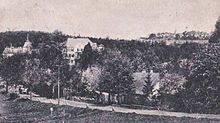Miedzianka (Janowice Wielkie)
Miedzianka ( German : Kupferberg im Riesengebirge ) is a place in the powiat Jeleniogórski in the Lower Silesian Voivodeship in Poland. He belongs to the rural community Janowice Wielkie (Jannowitz).
Geographical location
The village is located in Lower Silesia in the Hirschberg Valley , south of the city of Jelenia Góra (Hirschberg in the Giant Mountains).
history
Mining was already practiced in the village in the 12th century. The village of Kupfferberg is written on a map from 1561 . There was a brewery in the village.
In 1945, the place was known as Copper Mountain, was a city and belonged to the district of Hirschberg in district Liegnitz the Prussian province of Lower Silesia . With only about 600 inhabitants, the city was considered the smallest city in Prussia until modern times . The city's population was German and predominantly Protestant.
After the end of the Second World War , Kupferberg was placed under Polish administration by the Soviet occupying power, along with almost all of Silesia . The Poles introduced the Polish name Miedzianka for Kupferberg and withdrew its town charter. Unless the local German residents had fled beforehand, most of them were subsequently expropriated and expelled from Kupferberg by the local Polish administrative authorities . Maximilian Franz von Glyschinsky was the last German resident to leave his hometown in July 1957, together with his wife Charlotte, his children and his mother; Hedwig von Glyschinsky. In 1945 the Russian General Zhukov came to Kupferberg. Hedwig von Glyschinsky entertained him and his officers. Other German residents who remained at the time had barricaded themselves out of fear of the Russians. General Zhukov signed the von Glyschinsky family's guest book and offered to fly them to East Berlin, which Maximilian Franz von Glyschinsky refused. Maximilian Franz von Glyschinsky was the heir and only son of Maximilian von Glyschinsky (born as von Chamier-Gliszczynski , 1883–1944), mineral water manufacturer in Kupferberg, Markt 21.
After the end of the war, uranium ore was mined in Kupferberg . As a result of mining, the site, which had remained unscathed during the war, was largely demolished. After the uranium deposits had been exploited, the remaining Polish population was relocated to Hirschberg in 1972 and the brewery, which belonged to Georg Franzky until 1945, was continued by Poland until 1972 and then closed and the place left to decay. From the old Kupferberg only the Catholic Church still exists. The rows of houses and the rest of the village have disappeared, they were demolished in the mid-1970s. Today there are predominantly forest areas in the boundary of the former small town. A few years ago a modern brewery was put into operation on site.
The Polish journalist Filip Springer wrote the book Miedzianka, which has been available in German translation since October 2019 under the title Kupferberg. The missing place is there.
Population development
| year | Residents | Remarks |
|---|---|---|
| 1825 | 689 | including 125 Catholics |
| 1840 | 667 | 555 Protestants and 112 Catholics |
| 1900 | 533 | |
| 1933 | 616 | |
| 1939 | 635 |
Sons and daughters (selection)
- Hugo von Matuschka-Greiffenclau (1822–1898), landowner, politician, member of the Prussian mansion
- Irmela Hofmann (1924–2003), pastor and author
literature
- Filip Springer: Kupferberg. The vanished place. Paul Zsolnay Verlag, Vienna 2019, ISBN 978-3552059085 (German translation of the Polish-language original edition published in 2015 by Verlag Czarne, Szękowa under the title Miedzianka ).
Web links
- City of Kupferberg (Riesengebirge) , Rolf Jehke: Territorial changes in Germany and German administered areas 1874–1945
- Kupferberg - Chronicle of what was once the smallest town in Prussia , Heinz Kornemann, Wolfsburg 2008 (pdf)
Individual evidence
- ↑ Heinz Kornemann. Retrieved October 13, 2019 .
- ^ Johann Georg Knie : Alphabetical-statistical-topographical overview of the villages, spots, towns and other places of the royal family. Prussia. Province of Silesia, including the Margraviate of Upper Lusatia, which now belongs entirely to the province, and the County of Glatz; together with the attached evidence of the division of the country into the various branches of civil administration . Breslau 1830, pp. 950-951.
- ^ Johann Georg Knie : Alphabetical-statistical-topographical overview of the villages, spots, cities and other places of the royal family. Preusz. Province of Silesia . 2nd edition, Breslau 1845, pp. 847-848.
- ^ Meyer's Large Conversational Lexicon . 6th edition, Volume 11, Leipzig / Vienna 1907, pp. 834–835.
- ^ A b Michael Rademacher: German administrative history from the unification of the empire in 1871 to the reunification in 1990. hirschberg.html # ew39hbrgjannow. (Online material for the dissertation, Osnabrück 2006).
Coordinates: 50 ° 53 ' N , 15 ° 57' E




